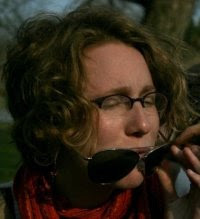Hello everyone!
I have been here for just over a week now and I’ve been having a beautiful time. I have had much to think about – and time to think! – and it’s been lovely. I thought, since I’m so far away from so many of you with whom I love to toss around ideas, that I would start a blog so I can share my time here with you, and hopefully not feel so far away.
I think I’ll start by explaining the title of my blog, and by extension, why I’m here. As many of you know I have moved to St. John’s, Newfoundland for the summer to study body mapping. Body mapping is a fairly new method of helping musicians to move (and play) with freedom and ease. Rooted in the somatic tradition of the Alexander Technique, it is based on the concept (recognized by neurologists as fact) that we all have a map of our bodies in our brains, and that we move according to our map. Body mapping is the process of consciously correcting one’s body map so one cane move healthily and beautifully. I discovered it two years ago when I came here for the Tuckamore Chamber Music Festival tired, in pain, and lacking the motivation to complete my music degree. When violin and body mapping teacher Jennifer Johnson and violin teacher Nancy Dahn introduced me to body mapping I found a way to play freely and without pain, and with it I rediscovered my love of music. I have returned to St. John’s twice since – once to take the weekend course in body mapping, What Every Musician Needs to Know About the Body and once last summer for Tuckamore. At home in Waterloo I have been studying and continuing to explore body mapping on my own. And now I am back to study in earnest for a few months.
“Radical uprightness” is a term I found in my body mapping book, How to Learn the Alexander Technique. Barbara Conable writes, “humans are the only vertebrates whose heads balance at the centre between the front teeth and the base of the skull, a feat which nature achieved slowly.” Picture a dog; a dog’s head meets its spine at the back, which is advantageous to quadrupedal movement. For bipeds, however, this would be highly inefficient. Gradually early hominids adapted to balance their heads further and further forward until in Homo Sapiens the head met the spine exactly in the middle. Paleoanthropologists call this radical uprightness. Many people, however move as if their head is balanced at the back (probably because the processes of the spine that we can see and feel are at the back) causing muscle pain and fatigue. This is one of the many things I am relearning.
When I came across this passage in my book I giggled because “radical” is a word with which I have a growing relationship. For a little more than a year now I have been singing in the Radical Choir of Waterloo Region and the various interpretations of “radical” is a topic that has come up in discussion more than once. Some see a radical as person who has made a choice to look critically at the world and challenge injustice wherever they find it, even if it means going against the grain of mainstream society. Some look to the word’s origin, “root,” (think radish) and relate it to words like “grassroots” and the feeling of being rooted. Some express frustration at being perceived as a radical when working for social and ecological justice shouldn’t be seen as extreme, but common sense.
So radical uprightness has a double meaning for me, but the two meanings are inextricably linked. As I have worked to develop my somatic (mind-body) awareness through body mapping I have become more self-aware in ways I never could have predicted. With greater self-awareness comes greater awareness of others and I have found myself opening up, more ready to trust, to step outside my comfort zone, to empathize. All of this has, of course, only deepened my relationship with social and ecological activism, with those around me, with myself.
It seems what I have always been looking for is a way to live with radical uprightness. I want to clarify, however, that by “uprightness” I in no way mean inflexibility or rigidity. Movement and freedom are what I am after! I am learning how to move through the world with resiliency, strength, gentleness, and thoughtful intention. I expect to falter along the way; I only hope to always be learning.
In relearning how to move according my body’s design I am exploring what it is to be human. I hope you’ll join me.
Much love,
Lauren
Subscribe to:
Post Comments (Atom)

No comments:
Post a Comment